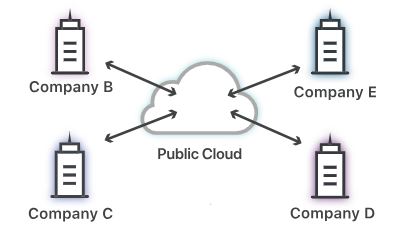Cloud Computing - Public Model
Cloud deployment models describe how cloud computing resources and services are hosted, managed, and made available to users and organizations. It simply refers to delivering computing resources, such as servers, storage, databases, software, and applications, over the Internet.
1. Public Cloud
In public cloud, computing resources are managed and operated by the Cloud Service Provider (CSP). These providers make their infrastructure and services available to the general public over the internet. The public cloud provider supplies the infrastructure needed to host and deploy workloads in the cloud. It also offers tools and services to help customers manage cloud applications, such as data storage, security and various monitoring and reporting capabilities. The IT giants such as Google, Amazon and Microsoft offer cloud services via Internet.

A common public cloud example is to think of it as similar to renting an apartment:
- You pay rent for a single unit
- The building manager handles the maintenance
- You share the overall space with other tenants, with security around your own belongings
How Public Cloud Work?
Using any number of virtual machines (VMs), which are divided from big collections of third-party-owned data centers, IT administrators can build a public cloud network. Third-party providers can provide end users with a variety of cloud services, from basic storage options to software programs and development tools—all accessible with an Internet connection—by virtualizing their compute, processing, and storage capabilities. These services are accessible to end customers from numerous organizations via mobile applications or other web portals.
Public cloud is owned, managed, and operated by businesses, universities, government organizations, or a combination of them.
For their services, third parties frequently demand a fixed or pay-per-use price. In exchange, the provider of public clouds takes over daily IT administration, including public cloud security. Google, Microsoft, Dropbox, and many other companies are examples of public cloud service providers.
Advantages of Public Cloud
There are the following advantages of public cloud.
- Low Cost - Public cloud has a lower cost than private, or hybrid cloud, as it shares the same resources with a large number of consumers.
- Location Independent - Public cloud is location independent because its services are offered through the internet.
- Save Time - In the public cloud, the cloud service provider is in charge of managing and maintaining the data centers where data is stored, allowing users to save time when configuring and assembling servers, establishing connectivity, deploying new products, and so on.
- Quickly and easily set up - Public cloud services are simple for businesses to purchase online, deploy, and configure remotely through the cloud service provider in a matter of hours.
- Business Agility - The public cloud offers the capability to elastically resize computer resources in accordance with the needs of the enterprise.
- Scalability and Reliability - Public cloud offers scalable (easy to add and remove) and reliable (24*7 available) services to the users at an affordable cost.
Disadvantages of Public Cloud
Public cloud have following disadvantage also.
- Low Security - Public Cloud is less secure because resources are shared publicly or any one can use.
- Performance - In the public cloud, performance depends upon the speed of internet connectivity.
- Less customizable - Public cloud is less customizable than the private cloud.
Next
